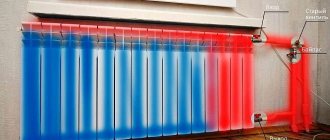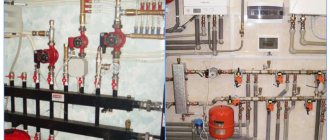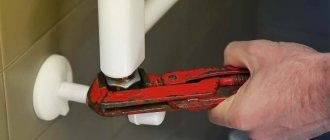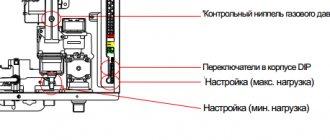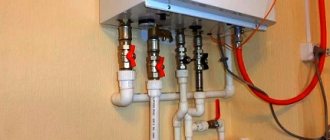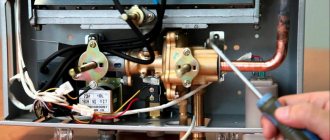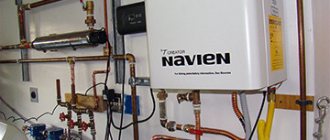If the heating system of a private home is filled with water or antifreeze, then air accumulations may occur in it for various reasons. They appear in different places and interfere with the normal circulation of the coolant, which leads to the cooling of both individual radiators and entire risers. It is clear that air should not be in the heating system and must be removed in one way or another. The purpose of this article is to identify the causes of air jams in the pipeline network and talk about how to “drive them out” into the atmosphere.
Gas boiler baxi eco four 24
A very popular series among all others in the BAXI line. The 4th generation boiler with a capacity of 24 kilowatts is available in various versions: with an open and closed combustion chamber. Boilers with a closed combustion chamber and forced smoke removal are designated by the letter “F” in the name. Baxi turbocharged boilers are the most popular and are often used when organizing apartment heating, so we will consider the use of an expansion tank in the heating system using this boiler model as an example.
Movement of coolant in the heating system
When organizing heating systems, various options can be used, but recently closed systems have become more popular, in which the coolant moves due to the operation of a circulation pump. A gas burner heats water (or antifreeze) in a primary heat exchanger, and a pump pumps it through a radiator system, transferring heat to the premises.
At the same time, for normal circulation of the coolant, the system must be completely filled with water, and since the liquid tends to expand when heated, it is necessary to somehow compensate for the increase in volume. This is why expansion tanks are provided in heating systems.
The diagram shows a system in which the boiler acts exclusively as a heater. In household wall-mounted boilers ECOFOUR, the expansion tank and circulation pump are already built-in, which is why such boilers are convenient to use in small apartments.
Causes and consequences
The reasons for the occurrence of air jams are the following factors:
- Errors were made during installation, including incorrectly placed bends or incorrectly calculated slope and direction of pipes.
- Filling the system with coolant too quickly.
- Incorrect installation of air vent valves or their absence.
- Insufficient amount of coolant in the network.
- Loose connections between pipes and radiators and other parts, which allows air from outside to enter the system.
- The first start-up and excessive heating of the coolant, from which oxygen is more actively removed under the influence of high temperature.
Air can cause the greatest harm to systems with forced circulation. During normal operation, the bearings of the circulation pump are constantly in water. When air passes through them, they are deprived of lubrication, which leads to damage to the sliding rings due to friction and heat or completely damages the shaft.
Water contains oxygen, carbon dioxide, magnesium and calcium in a dissolved state, which, when the temperature rises, begin to disintegrate and settle on the walls of the pipes in the form of limescale. Places of pipes and radiators filled with air are more susceptible to corrosion than others.
Signs by which you can determine whether there are air pockets in pipes and radiators
Due to air in the heating system, the radiators heat up unevenly. When checked by touch, their upper part, compared to the lower part, has a noticeably lower temperature. The voids do not allow them to warm up properly, so the room is less heated. Due to the presence of air in the heating system, when the water is very heated, a noise appears in the pipes and radiators, similar to clicks and water flowing.
You can determine the place where the air is located by ordinary tapping. Where there is no coolant, the sound will be louder.
Check the network especially carefully for leaks. When the heating is running, it is extremely difficult to identify leaky connections, since water quickly evaporates on a hot surface.
Design and location of the BAXI expansion tank
The baxi eco four 24 expansion tank is a red round tank located on the back wall of the boiler. The built-in expansion tank baxi with a volume of 6 liters is divided into two parts by an elastic membrane, one part is connected to the heating system, the second is pumped with air. Therefore, when the heating system heats up, the increasing volume of liquid overcomes the resistance of the membrane and fills the vacated volume of the tank, and when it cools, the membrane tends to move to its original position and pushes the liquid back into the heating system. Thus, the pressure in the heating system remains practically unchanged during operation.
What should be the pressure in the expansion tank of a BAXI double-circuit boiler?
If you open the instructions, it indicates the pressure in the expansion tank is 0.5 bar, but this is the minimum value, correctly - the pressure should be about 20% less than the pressure in the heating circuit at room coolant temperature.
Based on the fact that for most systems the recommended filling pressure is in the range of 1.2 to 1.5 bar, we obtain the required pressure in the air cavity of the expansion tank equal to 0.8-1 bar. Experts usually recommend setting the pressure in the BAXI expansion tank to 1 bar.
Do I need an expansion tank for a baxi wall-mounted gas boiler?
The volume of the built-in expansion tank of the baxi boiler is indicated in the characteristics and for the ECOFOUR series it is 6 liters. To answer the question of its necessity in a separate heating system, you need to know the total volume of this system.
Calculating it is not so difficult: the filling volume of the boiler and radiators is in their characteristics, and the filling volume of pipelines can be calculated by knowing their diameter and total length. Water, after heating by 80 degrees Celsius, will increase in volume by approximately 4-5%, therefore, the recommended volume of the expansion tank is 8% of the total volume of the heating system if filled with water and 12% if antifreeze is used as a coolant (thermal coefficient antifreeze expansion is greater). Thus, a standard expansion tank will be sufficient for a heating system with a volume of up to approximately 75 liters when using water and a volume of up to 50 liters when using antifreeze liquid.
These figures are conditional (with a margin) and when selecting the capacity of the expansion tank, you must be guided by the design calculations of a specific heating system, or the manufacturer’s recommendations.
In most cases, the built-in boiler tank is quite sufficient and the decision to use a separate additional tank is made by specialists at the design stage.
Malfunctions of expansion tanks
Checking the pressure of the expansion tank is included in the list of annual maintenance procedures and if it is followed there will be no problems, but if neglected it can give the owner unpleasant surprises:
the pressure in the air chamber gradually decreases and with each refill of the boiler the tank fills more and more with water and gradually ceases to perform its function. In this case, the membrane is so pressed against the wall of the air part of the tank that it can be damaged by the valve spool and the tank will have to be replaced.
The heating circuit pressure is at the permissible limit, the expansion tank has not been serviced - there is no pressure in it. When the heating system cools down, the volume of liquid decreases, the pressure drop is not compensated for by anything - the boiler stops due to an emergency. This situation can arise, for example, when the boiler operates for a long time in DHW mode or when there is a power outage.
the owner of the boiler often has to top up the boiler for no apparent reason, for example, while hot water is being used - the pressure on the pressure gauge drops and the boiler stops by mistake - the owner tops up. Since thermal expansion is not compensated by anything, with further heating of the coolant, excess pressure is released through the safety valve. Some users set the reset and simply do not notice this situation. Frequently refilling the boiler with untreated water is detrimental to the heat exchanger!
Installation of air vents
At all upper points of the system, be it pipeline bends or radiators, you need to install air vents - the main weapon in the fight against traffic jams. The air vent can be automatic (valve) or manual (Maevsky valve). The automatic valve will do everything itself, unnoticed by the owner.
In order for the automatic air release valve to work properly, you need to ensure that the coolant is clean at all times.
Internal structure of an automatic air vent
In manual mode, if signs of airiness occur (decrease in temperature in the area, gurgling, drop in pressure), you need to immediately take care of bleeding the air.
When replacing a radiator, they buy an installation kit, which contains everything necessary for installation, including the Mayevsky tap. But air vents are also sold separately. They are placed in the upper fitting of the radiator, on the opposite side from the supply inlet.
Perhaps everyone knows that a certain amount of air accumulates in the heating system, which needs to be vented. The Mayevsky tap is now installed on almost all radiators. Let's look at the structure of this device.
The operating principle of a storage water heater and the advantages of this device are described on this page.
Baxi boiler pressure drops when hot water is turned on
Sometimes, users encounter a problem when the pressure drops when turning on hot water in the baxi boiler. This problem may just be due to insufficient pressure in the expansion tank. The fact is that when the boiler switches to the hot water preparation mode, the circulation pump pumps the liquid in a small circle, i.e. only inside the boiler itself - through a secondary plate heat exchanger. In this case, the heating circuit actually does not heat up and the coolant begins to cool, the volume decreases and in the absence of compensating pressure in the expansion tank, the pressure of the heating system may drop and the boiler will display error E10.
In such a situation, you can also consider the possibility of a breakdown of the heat exchanger itself (a gap between the plates) and water from the heating circuit entering the hot water system, but this is easy to check. To check, you need to shut off the cold water supply to the boiler and open any drain valve. If under such conditions water comes out of the tap, it is obvious that this is coolant from the heating circuit and the heat exchanger needs to be replaced.
Remember, timely maintenance of a gas boiler will help avoid such situations and increase the service life of the unit.
We also recommend watching a video from one of the users, which clearly shows how to pump up pressure in the expansion tank:
The last stage of installation of almost any heating system is its first trial run, debugging and commissioning. By and large, if boiler equipment is started up for the first time, then this work is a priority for service centers. During the first start-up, service center specialists check the correct connection of the boiler, perform its debugging and put this equipment under warranty. If you carry out the first start yourself, then you cannot count on warranty service from the service center. Starting and debugging the heating system can also be done while the system is in operation - you won’t have to turn to specialists every time. Owners of individual heating simply need to know this process. We will study it with you in this master class with step-by-step photos, in which, together with the website stroisovety.org, we will study in detail the issues of how to start a boiler and how to debug the heating system with your own hands.
Reasons for increased pressure. Ways to solve the problem
You can tell if there is too much pressure in the system by looking at the pressure gauges. Normal readings are 1-2.5 Bar. If the pressure gauge needle reaches 3 Bar, sound the alarm. If the increase is constant, it is urgent to find the cause and reduce the pressure.
Also pay attention to the safety valve: it will constantly release water to relieve pressure.
The problem is in the expansion tank
This tank can be located separately from the boiler or be part of the structure. Its function is to collect excess water when heating. Hot liquid expands, it becomes 4% larger. This excess is sent to the expansion tank.
If the volume of the product is too small, it will be completely filled with water. With a subsequent increase in temperature to 85-90 degrees, the tank will no longer be able to compensate for this 4%. Therefore, the pressure will increase.
The size of the tank is affected by the power of the boiler. For gas equipment, its volume is 10% of the total amount of coolant. For solid fuel - 20%.
Membrane rupture. If a part is damaged, the coolant is not restrained by anything, so it completely fills the compensation tank. Then the pressure begins to drop. If you decide to open the tap to add water to the system, the pressure will rise above normal. The connections will leak.
The tank or membrane needs to be replaced to reduce the pressure.
The pressure is below or above normal . A machine pump will help to achieve normal values (nominal) in a gas boiler.
- Drain all water from the system.
- Close the valves.
- Pump the circuit until you are sure there is no water.
- How to bleed air? Through the nipple on the other side of the inlet.
- Download again until the indicators reach the norm specified in the instructions for Ariston, Beretta, Navien and other brands.
The location of the tank after the pump provokes hydraulic shocks . It's about how the pump works. When it starts, the pressure rises sharply and then drops as well. To avoid such problems, in a closed heating system, install the tank on the return pipe. The next one to cut in is the pump in front of the boiler.
Why does pressure increase in closed systems?
Air accumulates in a double-circuit boiler. Why does this happen:
- Incorrect water filling. The fence is carried out from above, too quickly.
- After the repair work, excess air was not released.
- Mayevsky's air release valves are broken.
- The pump impeller is worn out. Adjust or replace the part.
To relieve or reduce pressure, fill the fluid correctly. The intake is carried out from below, slowly, while the Mayevsky valves are open to bleed off excess air.
Open system problems
The problems are the same as described above. It is important to fill water and bleed air correctly. If after this the pressure does not return to normal, it is necessary to drain the system.
Secondary heat exchanger
The unit is used to heat hot water. Its design consists of two insulated tubes. Cold water flows through one, and already heated water flows through the other. If the walls are damaged or a fistula appears, the liquids mix and enter the heating part. Then the pressure increases.
If you do not want to repair and solder the heat exchanger, you can replace it. To do this, buy a repair kit and get to work:
- Close the supply valves.
- Drain the water.
- Open the case and find the radiator.
- The unit is secured with two bolts. Unscrew them.
- Remove the faulty part.
- Install new gaskets at the fastening points and connect the heat exchanger.
Other reasons
There are other reasons for such problems:
- The fittings are blocked. When collecting, the pressure increases and protective sensors block the equipment. Inspect the taps and valves, unscrew them until they stop. Make sure the valves are working properly.
- The mesh filter is clogged. It becomes clogged with debris, rust, and dirt. Remove and clean the part. If you do not want to clean regularly, install a magnetic or flush filter.
- The feed tap has failed. Perhaps its gaskets are worn out, then you can get by with a replacement. Otherwise, you will have to change the tap.
- Problems with automation. Faulty thermostat or controller. The reason is wear and tear, manufacturing defects, or incorrect connection. Diagnostics and repairs are carried out.
Check whether the boiler protection parts are in good working order: pressure gauge, valve, air vent. Clean radiators and other components from dust, soot, and scale. Prevention helps prevent serious breakdowns of gas equipment.
Filling the heating system with water
Starting a gas boiler begins with filling the heating system with water. Everything is simple here - modern double-circuit boilers do not require the installation of a special system feeding unit. It is already built into the boiler and equipped with a special tap, which, as a rule, is located at the bottom of the boiler in close proximity to the cold water connection pipe. Open the feed tap and slowly fill the system with water.
Starting the boiler - how to fill the system with water
A very important point in the operation of any boiler equipment is fluid pressure. To control this parameter of the heating system, almost all boilers are equipped with a pressure gauge. During the process of filling systems with water, it is necessary to monitor the pressure and after it reaches 1.5-2 atm, filling the system will need to be stopped. In principle, the operating pressure of a boiler may vary depending on the manufacturer and model - therefore, see the instructions for the boiler for the exact operating pressure.
Do-it-yourself first start-up of a gas boiler
Why does pollution occur?
The problem with clogging of metal pipelines is rust.
Accumulating inside the system, it prevents the free circulation of the coolant, and as a result, malfunctions occur in the heating operation. As for plastic pipes, they are naturally not susceptible to rust, but, nevertheless, scale appears on their walls, which also contributes to malfunctions of the heating system.
One of the causes of pollution is also the quality of water, which may contain various impurities that cause pipes to clog.
Thus, there are the following types of blockages:
- scale;
- rust;
- silty sand;
- garbage.
Removing air pockets in the system
Simply filling the heating system with water is not enough; in order to fully start the heating system, it is necessary to release the accumulated air from it. Most modern heating boilers are equipped with an automatic air release system, but, as a rule, they work inefficiently and therefore, at least from the main components, it must be removed manually. Starting the heating system involves eliminating air pockets in the radiators and circulation pump.
It's better to start with batteries. To remove air pockets, a Mayevsky tap is usually installed on them. We open it and wait for the water to run. Did you run? Let's close. Such manipulations must be done with each heating device separately.
How to start a boiler with your own hands photo
After the air is removed from the batteries, the pressure in the system will decrease and the pressure gauge needle will drop. At this stage of work, the solution to the question of how to start the boiler involves re-filling the system with liquid.
Now, the most difficult thing is that starting gas boilers requires bleeding air from the circulation pump. To do this, the boiler needs to be disassembled a little. We remove the front cover and look for a cylindrical object with a shiny lid in the middle, which has a slot for a screwdriver. After we have found it, we put the boiler into operation - we supply it with electrical power and set the water heating controls to the operating position.
Relieving air from the circulation pump when starting the boiler photo
The circulation pump will immediately turn on - you will hear a faint hum and loud gurgling and many incomprehensible sounds. This is fine. As long as the pump is aired, it will be so. Take a screwdriver and slowly unscrew the cap in the middle of the pump - as soon as water starts seeping out from under it, screw it back. After two or three such manipulations, the air will come out completely, the strange sounds will subside, the electric ignition will work and the heating boiler will start working. Check the pressure again and add water to the system if necessary.
Basically, that's it. While the system is warming up, you can begin to study the instructions in detail (if, of course, you have not already done so) and start debugging the system that involves starting the boiler. Everything is simple here - the batteries closest to the boiler need to be screwed on, and the ones farther away need to be turned on to their full potential. This debugging is carried out using control valves installed on the supply connection pipe to the heating radiator.
Author of the article Alexander Kulikov
If you liked it, share it with your friends
It’s extremely useful to know about bleeding air from the pump, because... I’m reading this for the first time, but I figured it out the second time. Let me add - if the pump does not turn (it gets stuck after being idle) - under this nut, turn the pump shaft several times with a flat screwdriver (this is also written in the instructions).
Damn, thanks. It wouldn't start until I cranked it. Not a single piece of paper states n7e (baxi5)
And they won’t indicate it, since the first start-up of the boiler must be done by representatives of service centers.
To start the boiler normally, you need step-by-step instructions for starting the boiler by the user and there is no need to invent the responsibility of a super-duper serviceman to perform this work. This is one of the boiler manufacturer’s tricks to avoid possible defects in their products.
Hello, what if you already started it up and then drained all the water from the system, and now how can you start the boiler again?
Tell me, I planned to do the first start-up of the Beret boiler (chimney), but when I just plug it into the network without filling the system with water, it shows error A 03! what to do - call a service or fill the system with water and start it yourself.
Hello. Naturally fill with water. No boiler will turn on until the system has the required pressure.
Very informative, thank you! For all work related to the heating system, we turn to specialists!
Shouldn't the expansion tank valve be opened?
Hello Yuri. As a rule, modern boilers, or rather their expansion tanks, are equipped with automatic air vents - it works regardless of whether you unscrew the cap on it or not. And getting to this dump is not so easy. This is unless you have a separate expansion tank, which is equipped with a regular tap instead of a machine - in this case, yes, you need to bleed the air from the expansion tank.
Good evening! Please tell me I have a pump and it’s obviously clogged, if I unscrew the cap in the middle and turn the rotor in the direction of the arrow, will water flow out?
Hello Igor. Probably the pump has not been used for a long time. Usually this only happens if the pump has been inactive for a year or more. Yes, you can do this thing - unscrew the screw and try to turn the pump by hand. This is often difficult to do. In general, when the boiler is inactive, the pump rotor even needs to be periodically turned or the boiler turned on, at least for a few minutes.
Hello. Help, otherwise I don’t even know what the problem could be... The situation is as follows: The heating radiators have stopped warming up normally, they are almost cold from below. They used to heat it up great, but now they just don’t want to. The boiler is a double-circuit boiler with a closed system, no air comes out through Mayevsky (I bleed it - everything is fine), the pump works (I hear it when I listen), there are no extraneous noises. I adjust the batteries closest to the boiler (by tightening the supply) - nothing changes... What could be the problem? And yet... I noticed that when I turn off (shut off) the nearby batteries, and leave them only in the far room (it also warms up by half), the boiler heats up very quickly (up to 15 seconds) and turns off, although the battery has not warmed up... What could be the problem ? Before everything worked and warmed up normally. The heating was installed 4 years ago... and every year it gets worse... there is no garbage inside either... I drained the water... let the running water through... everything flows and is clean. I would appreciate your help. Thank you!
Hello Victor. From what you described, there is a clear sign of poor or absent circulation. Look, if you close everything and leave the last battery and the boiler turns off after 15 seconds, then the coolant simply does not flow in a full circle.
We need to find the location of the problem. We open the batteries one by one - first the penultimate one, then the penultimate one)). In general, we move towards the boiler every time. When we opened the new battery, we look at how the boiler works. The moment when it works normally will indicate to you the problematic part of the pipelines. Now we do the opposite - close the problematic part and open the remaining one. Again, let's see how everything works. If it starts working normally, then the system needs to be flushed or purged - and this must be done through each line.
What kind of pipes? Polypropylene? Perhaps there is a joint somewhere that was overheated during soldering - a small hole is slightly clogged and that’s it, there is no circulation. It is very difficult to look for such a place - you need to put yourself in the place of the shareholder and determine among all the connections the most inconvenient - the likelihood that there is a problem there is very high.
Prevention
To avoid problems with air locks, it is necessary to install air vents at each group of heating elements. So, for example, to remove air from the boiler, an automatic valve for removing gases is mounted directly on it. All collectors are also equipped with it. Mayevsky taps are installed on the radiators at the end.
If, after bleeding the air, the radiators still do not heat up well, the coolant should be completely drained. Since it is possible that there is too much dirt in the network, and it significantly reduces the circulation of fluid in the batteries.
https://youtube.com/watch?v=xUO58oC8yX8%3F
The forum was created for beginners and experienced plumbers, welders, mechanics, electricians and construction workers. Share your experience and receive competent answers from specialists.
- Unanswered topics
- Active topics
- Search
- Users
- our team
Selection of coolant
If you fill the circuit with low-quality coolant, the equipment will not last as long as it could. Therefore, before filling the heating system in a private home, you need to select a coolant suitable for your situation. There are only two options - water or non-freezing liquid. In a house where you live constantly, it is better to give preference to water, since there are fewer problems with it, especially if it is distilled. Such water contains almost no impurities of salts and metals, which negatively affect all elements of the heating circuit.
Non-freezing liquid thickens at sub-zero temperatures. It is used when the heating works from time to time. The characteristics of non-freezing liquid impose some restrictions:
- high degree of fluidity - leakage may appear where water would not leak;
- Do not overheat - when heated to 95 degrees, it decomposes into acid and other elements;
- if the liquid has thickened, then heating should be gradual;
- Anti-freeze has a resource (depending on the manufacturer, on average 2 seasons).
Polymer thermal insulation Penoplex has one of the lowest thermal conductivity coefficients.
If you insulate a timber house with Penoplex, the wood will not breathe and will rot very quickly.
Antifreeze cannot be used if you have a double-circuit boiler installed. Liquid can seep through protective gaskets, so it happens that colored water flows from a hot water tap. In any case, only non-toxic antifreeze based on propylene glycol should be poured into the system. After all, there is also antifreeze based on ethylene glycol - this is car antifreeze. Some people also pour it into the heating system, but we do not recommend doing this.
Signs of air accumulation: how to bleed the battery
Determining whether your batteries are airy is not difficult.
The following signs indicate this:
- Heat transfer has noticeably decreased (radiators that were previously hot stopped heating);
- You began to notice the presence of noise, crackling, gurgling and a decrease in pressure in the pipes;
- If you have autonomous heating, then an increase in fuel consumption will become obvious;
- Liquid has stopped moving through the system and circulation is disrupted.
The presence of air in radiators threatens not only a decrease in temperature, but also more global problems. For example, batteries made of steel begin to oxidize, rust and fail. Bottlenecks become silted and need to be flushed out or completely replaced. If your heating is individual, then the accumulated gas in the system can lead to failure of the circulation pump, because in normal condition the bearings are constantly in water. In case of airing, the installation is subjected to dry friction, which causes excessive heating and shaft failure.
How to fill a heating system through make-up
Filling a closed-type heating system through make-up is only possible if the circuit is connected to a water supply system. In autonomous systems, this is the best option, since it does not require the purchase of additional equipment.
It is advisable to install not a ball valve on the feed, but a valve that can be used to regulate the flow. Before filling the heating system with water, you need to empty it of old coolant. The water changes because it becomes too dirty. Then you need to open all the Mayevsky taps on the radiators and open the make-up.
As the radiators fill, liquid will begin to flow from the air vents at the ends. As soon as water appears, the tap is immediately turned off. You need to monitor the readings of the pressure gauge - a device that shows the pressure in the heating circuit.
In autonomous systems it should not be more than 2.5 atmospheres. This value is achieved when the temperature of the coolant increases, and when the water is cold, the pressure gauge should show no more than 1.5 atmospheres.
After filling the heating system with water, you need to turn on the boiler. When the coolant heats up, you need to bleed air from all batteries again. In hot water, air separation occurs more intensely than in cold water. It may be necessary to remove air pockets several times (the first 2-3 heating cycles of the coolant).
Mayevsky crane how to bleed air
The Mayevsky crane should be given special attention. This is a needle radiator unit that includes an air valve, screw and cone-shaped body design.
All these parts are tightly adjacent to each other, which completely eliminates the leakage of water. As for the air that may be in the radiator, it exits through a small hole located on the side of the tap. Such an installation can be opened using a special key, which is always included in the kit; if one is missing, then you can use a regular screwdriver, and some models provide the ability to open manually.
If we take into account a modern bimetallic installation, then they already have holes for installing taps. The Mayevsky tap itself must be installed in such a way that the air vent tube is located on the opposite side and is parallel to the floor
If your batteries are made of cast iron, then automatic air vents are best suited here. They correspond to the design features and composition of the material.
In order to remove air using a Mayevsky tap, you need to follow a sequence of certain actions.
In order to bleed air in the Mayevsky tap, you should first prepare a screwdriver and a container
- Prepare keys or a screwdriver, a container for liquid and a rag;
- If your system includes a pump, then it must be temporarily turned off;
- Place the container under the tap and carefully turn it counterclockwise;
- Air will begin to drain from the faucet and may include dirt or rust;
- You need to wait until water flows from the tap and turn it off.
If the water quality is not the best, then you need to install a few additional shut-off valves. They should be located up to the Mayevsky tap and protect it from possible blockages.
Filling closed heating with a pump
If the circuit is not connected to the water supply, the only option left to fill the heating system is a pressure test pump. This is a small rectangular metal reservoir into which liquid is collected. From the reservoir, the coolant is supplied to the pipes thanks to a pump-action hand pump on which a pressure gauge is installed.
Hand pump for pressure testing.
There is nothing complicated about how to fill a closed heating system. Work algorithm:
- connect the hose from the pump to the circuit;
- pour coolant into the pump reservoir;
- manually pump fluid into the system.
If there is no pipe for draining water from the circuit, then you can connect the pump hose to one of the ends of the battery. To do this, you need to unscrew the plug and put the adapter in its place. Before starting work, be sure to open all air vents so that air can leave the circuit.
There is no point in gluing roll insulation under the wallpaper. A thin layer of thermal insulation will not give the desired result.
When working with thermal insulation in sheets and rolls, you need to use an insulation dowel or nail to fix the material.
Watch the pressure gauge reading carefully. Using such a pump, pressure testing of the heating system is carried out. They can pump up pressure to 10 atmospheres (if you have enough strength). When filling the system, such pressure is not necessary, otherwise the boiler will break.
Water heating with natural circulation
Open heating system
Heating water systems without a pump are usually classified according to certain characteristic criteria that reflect their functionality.
Depending on the type of expansion tank, heating with natural circulation is usually divided into the following types:
- Open heating system. With this design, the expansion tank is located as high as possible in order to create excess pressure and also to remove air. In this case, the tank also serves to add fluid to the system.
- A closed heating system with natural circulation is distinguished by the fact that instead of an expansion tank, a membrane hydraulic storage cylinder is installed, with the help of which an additional pressure of no more than 1.5 atm is created. To ensure safety, a block with a pressure gauge is built into the design of the system, which regulates the internal pressure.
You can read about the features of the Wilo circulation pump here.
Also, heating structures with natural circulation are divided depending on the method of connecting the heating elements. According to this classification, there are the following types of heating:
- Single pipe heating system. The operating principle of this type of heating is that all heating devices are connected to the system in series, in other words, the coolant circulates from one element to another. The undoubted advantage of this type of heating is that installation is quite simple and requires a minimum of materials.
- Two-pipe heating system with natural circulation. In this heating design, the heating elements are connected to the main pipe in parallel. In other words, the coolant enters each device at the same temperature, and the cooled liquid returns to the boiler through a pipe, which is commonly called “return”.
This heating scheme is the most optimal for heating a living space. The only drawback is that the installation of such heating requires a large number of pipes and other plumbing fittings.
Builder's advice: when choosing a heating system for your home, be sure to consider your options when purchasing all the consumables for heating installation.
Filling the system through a double-circuit boiler
Now let's look at the simplest method, namely how to fill the heating system of a double-circuit boiler. These units do not require the installation of an additional unit for feeding the heating circuit, since it is included in the basic configuration.
The feed tap is located at the bottom.
Look into the bottom of the boiler. Near the cold water supply pipe from the water supply there should be a plastic handle for the make-up tap. In principle, the procedure is no different from refilling through a water pipe:
- open all air vents;
- open the feed tap and fill the system;
- As the circuit fills, close the air vents;
- we achieve pressure (specified in the boiler passport).
After the pressure in the heating system has reached the required level, the make-up valve closes. He won't be used until next season. It is recommended to change the coolant every year. For more information on how to fill a closed heating system, watch the video below.
What is an airy battery and how to determine it
If you see that the batteries are not heating up to full capacity, even though just yesterday the whole system worked perfectly and the house was warm, as if the whole difficulty is that you just need to bleed the air from the battery that is not very hot. This article will tell you in detail how to bleed air from a battery.
Before you bleed air, make sure that it is actually considered to be the cause of the system failure.
First, you need to check all the batteries: if they are all too cold or, on the contrary, too hot, the problem may be specifically in the heater, or perhaps other sediment has collected in the batteries. Also check to see if water is dripping from the batteries. There may be a leak in the battery, then you just need to turn off the heating system and tighten the nut on the battery inlet valve.
If the situation has not changed as a result of the actions taken, the nut may have become corroded and needs to be replaced. There may be such aspects that on the upper floor the batteries remain cold, while the batteries below are heated quite well. In such cases, it is best to call a specialist who specializes in this area.
And if, as a result of a detailed examination of the heating system, you have not identified any other problems besides the fact that any battery is completely or partially cool, then you just need to understand how to bleed the air from the battery.

